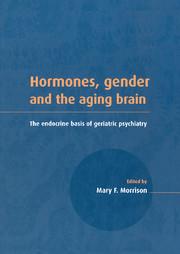Book contents
- Frontmatter
- Contents
- List of contributors
- Preface
- Acknowledgments
- Part I Overview
- Part II Hormones and mental health in the elderly
- 3 The hypothalamic–pituitary–adrenal axis in aging: preclinical and clinical studies
- 4 The hypothalamic–pituitary–thyroid axis
- 5 Estrogen and depression in aging women
- 6 The role of testosterone in male depression
- 7 Dehydroepiandrosterone in aging and mental health
- 8 Sex hormones, cognition, and dementia in the elderly
- 9 Effects of estrogen on basal forebrain cholinergic neurons and cognition: implications for brain aging and dementia in women
- 10 Gender and schizophrenia
- 11 Sex steroids and anxiety disorders
- 12 Gender and hormonal factors in pain and pain inhibition
- Part III Effects of hormones and behavior on immune function
- Part IV Hormones and gender differences in psychotropic drug metabolism
- Index
7 - Dehydroepiandrosterone in aging and mental health
from Part II - Hormones and mental health in the elderly
Published online by Cambridge University Press: 18 September 2009
- Frontmatter
- Contents
- List of contributors
- Preface
- Acknowledgments
- Part I Overview
- Part II Hormones and mental health in the elderly
- 3 The hypothalamic–pituitary–adrenal axis in aging: preclinical and clinical studies
- 4 The hypothalamic–pituitary–thyroid axis
- 5 Estrogen and depression in aging women
- 6 The role of testosterone in male depression
- 7 Dehydroepiandrosterone in aging and mental health
- 8 Sex hormones, cognition, and dementia in the elderly
- 9 Effects of estrogen on basal forebrain cholinergic neurons and cognition: implications for brain aging and dementia in women
- 10 Gender and schizophrenia
- 11 Sex steroids and anxiety disorders
- 12 Gender and hormonal factors in pain and pain inhibition
- Part III Effects of hormones and behavior on immune function
- Part IV Hormones and gender differences in psychotropic drug metabolism
- Index
Summary
Introduction
Dehydroepiandrosterone (DHEA) and its sulfated metabolite, DHEA-S (together abbreviated DHEA(S)), are quantitatively the most important adrenal corticosteroids in man, although their physiological roles are unknown. These steroids have captured widespread scientific and public attention in recent years due to three key observations. First, circulating levels of these steroids progressively decline from young adulthood through the end of the lifespan; they also decrease in response to chronic stress or illness. Second, preclinical studies suggest that DHEA(S) protects against certain pathological processes seen in illness and with aging. Third, some epidemiological studies in man suggest that relatively higher DHEA(S) levels are associated with enhanced physical and mental well-being. Such findings have raised hope that replacement dosing with pharmaceutical DHEA may enhance and prolong life, although very limited clinical data exist to support this. This chapter will review preclinical and clinical data regarding the effects of DHEA(S) in the central nervous system, its biological role in aging and mental health and its possible efficacy in treating neuropsychiatric illness in the middle-aged and elderly.
DHEA(S) as a neurosteroid
DHEA(S) is synthesized in situ in brain, with glial cells playing a major role in its formation and metabolism; it has therefore, been termed a neurosteroid (Baulieu, 1997). Accumulation of DHEA(S) in rat brain is largely independent of adrenal and gonadal synthesis, remaining constant after orchiectomy, adrenalectomy and dexamethasone administration (Robel & Baulieu, 1995; Corpechot et al., 1981).
- Type
- Chapter
- Information
- Hormones, Gender and the Aging BrainThe Endocrine Basis of Geriatric Psychiatry, pp. 144 - 167Publisher: Cambridge University PressPrint publication year: 2000
- 1
- Cited by



